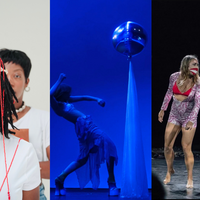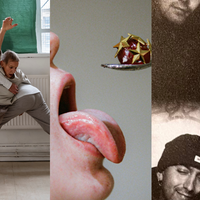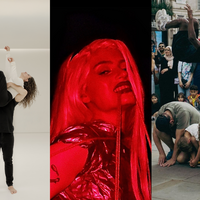Thu 6 Feb: Andrei Nistor, Samara Langham and Seirian Griffiths

News Story
Andrei Nistor DE-DEOCHI
Samara Langham Skye Zone Burial
Seirian Griffiths Dead End Resurrection
With a carefully crafted stage design, featuring red apples circling antlers at the centre of the stage and alongside a traditional Romanian costume in red tones, Andrei Nistor creates a powerful atmosphere from the first moment of De-Deochi. The performance begins with a sense of calm as Andrei embodies subtle movements, allowing his beautifully mesmerising stage presence to capture the audience’s undivided attention. As his movements evolve from conveying a subtler, rhythmically precise, sharp yet alluringly smooth quality to becoming more expansive, the soloist creates an empowering and liberating energy. Ongoing spirals and circular motions enhance a sense of ecstatic transformation. While wearing the antlers and embodying an animalistic persona in the second part of the performance, Andrei gracefully confronts and engages with the audience, making them feel what it means to observe a living being. The inevitable question of the nature and implications of one’s gaze arises.
Choreographer Samara Langham, in collaboration with sound and lighting designers Jasper Maurice and Edward Saunders, establishes an alien-like, enigmatic atmosphere. A cold and stark light, accompanied by dark, reverberating sounds, conjures an ephemeral-feeling space. Three dancers move in ways that evoke the image of otherworldly creatures, reinforcing a sense of an incomprehensible reality, which contrasts with the more linear, clearly defined pathways of travel on stage. There are moments when the three individuals seem to be so deeply linked that even the slightest movement impacts the entire structure of the three bodies, hinting at the interconnectedness of the world we live in. Recurring blackouts contribute to the performance’s occasionally elusive and fragmented quality – but perhaps this is exactly what constitutes the nondescript, associative nature of a dream.
Dead End Resurrection depicts a clearly troubled and fraught relationship between the two dancers on stage. In his choreography, Seirian Griffiths draws on elements such as active and passive roles, the manipulation of the other body, gestures like handshakes and actions like faltering, falling, pushing, pulling and collapsing, to communicate the tensions of a deeply distressed relationship. Although abusive dynamics are unmistakably evident, the highly skilled partnering also creates moments where the two bodies seem to interlock like gears, evoking instances of flow and fleeting glimpses of potential trust amidst what seems like a hopeless, ongoing conflict.
Livia Nissen
From the advantage of sitting in the round, we are immersed in an evening of three differently intense works. First up, and possibly the hardest to navigate due to its intangible theme and the dancers' ambiguous relationship with each other is Samara Langham’sSky Zone Burial. A golem-like creature with a bloodied arm and gnarled limbs (Jesse Baggett-Lahav), furtively leads us to an imaginary place, which feels remote and strange, partly conveyed by Jasper Maurice’s foreboding, experimental sound design. Joined by Elvi Rose Christiansen Head and Mark Halton the three dance in unison, juxtaposing intriguing phrases of stumbling, jerky prances with scenes of poised, ceremonial rituals. Langham taps into a fascinating, sensorial otherworldliness that is articulated beautifully through sound, light and choreography but Sky Zone Burial and its cold shifting skies, feel just out of my grasp.
Romanian folklore, rituals and storytelling form the backbone of Andrei Nistor’s mesmerising De-Deochi (evil eye). Wrapped in colourful layers of traditional Balkan costume, Nistor slowly circles the red apples that surround his shaman’s shrine. Gathering pace to conjure the spirits that will ward off the evil eye, he enacts a staggeringly virtuosic fusion of Balkan folk and contemporary dance culminating in an ecstatic spinning sequence where he seems magically possessed. A blackout and the faint howl of wolves in Adrian Piciorea and David Lunca’s rich music score, signal a sinister change. Adorned in his shaman's headdress, Nistor staggers amongst the dark forces like a wild animal, reaching out pleadingly to entranced audience members. Transporting us to an ancient world of folk superstitions, he has us transfixed.
Seirian Griffiths makes us shudder with horror in Dead End Resurrection, which stages another kind of ritual – played out by a heterosexual couple, trapped in a repetitive cycle of love, abuse and finally murder. Protagonists, Sophie Ormiston and William “JJ” James brilliantly embody seedy, dysfunctional people addicted to a doomed relationship. This hackneyed theme feels like the least interesting aspect of the work but how they interpret the manipulation, coercion and violence on each other's bodies through a hyper-physical language of contact improvisation, on steroids, is gripping. Ormiston and James’s seamless phrases of pushing, rolling, surfing, flipping, flopping, ducking, diving, dying then repeating, so deserve the roaring applause they receive.
Josephine Leask


